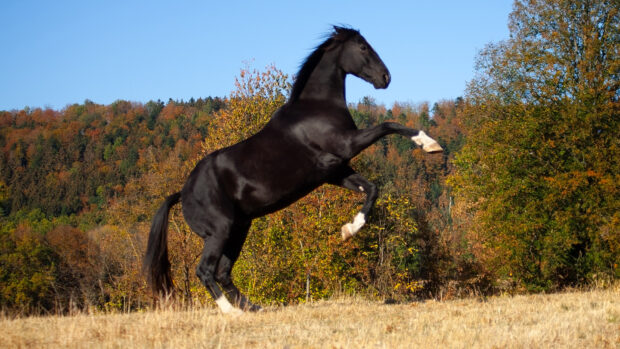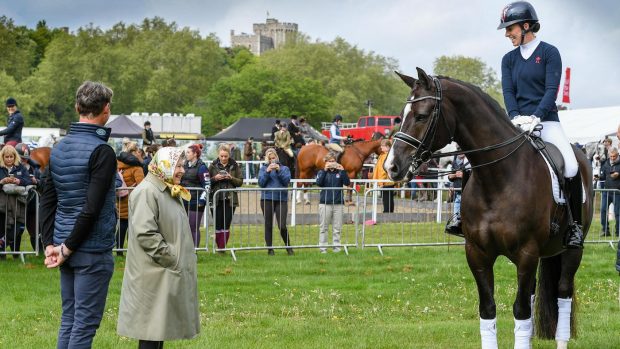In the previous articles in this series, Horse & Hound has spoken to top trainers to find out how to improve rider balance while riding at home. But what horse rider strengthening exercises can you do off the horse?
Rider, coach and equine-specific personal trainer Christine Gay says that what happens off the horse impacts riding. “It’s important to have an awareness of our posture, strengths and weaknesses,” she says.
“However a rider walks, sits or stands will be reflected in their posture on a horse. So, if you have an asymmetry – for example, you drop through a hip – but only ever work on it when you’re riding, you’ll only see limited progression.”
Christine says balance and strength are interlinked, and cultivating strength and symmetry in the body means riding with appropriate levels of suppleness and resistance.
“You have the rider who’s tense, showing too much resistance, the rider who’s too supple and has no stability, and the toned rider who is supple enough to absorb the horse’s movement, but can at the same time resist it to stay stable in the saddle,” Christine explains.
“It’s about finding a balance between all three. You have to have strength to have tone, but you don’t want to go to the extreme of becoming tense.”
Many equestrians are pressed for time, although Christine says horse rider strengthening exercises can fit around equine and work commitments.
“We only ride for a limited time, so any extra time spent working on symmetry and strength is beneficial,” she adds. “In five minutes while the kettle boils or you’re waiting for the farrier, you can do something small to improve yourself.”
Horse rider strengthening exercises: before you begin
{"content":"PHA+Q2hyaXN0aW5lIGV4cGxhaW5zIHRoYXQgYW55IHBoeXNpY2FsIGV4ZXJjaXNlIHNob3VsZCBiZSBjb25kdWN0ZWQgd2l0aCBjYXV0aW9uLiBTaGUgYWR2aXNlcyBjb25zdWx0aW5nIHlvdXIgR1AgYmVmb3JlIGVuZ2FnaW5nIGluIGFueSBvZiB0aGVzZSBob3JzZSByaWRlciBzdHJlbmd0aGVuaW5nIGV4ZXJjaXNlcyBpZiB5b3U6PC9wPgo8dWw+CjxsaT5oYXZlIGEgaGVhcnQgY29uZGl0aW9uPC9saT4KPGxpPmZlZWwgY2hlc3QgcGFpbnMgd2hlbiBleGVyY2lzaW5nLCBvciBoYXZlIGhhZCBjaGVzdCBwYWluIGluIHRoZSBsYXN0IG1vbnRoIGF0IHJlc3Q8L2xpPgo8bGk+ZXhwZXJpZW5jZSBkaXp6aW5lc3M8L2xpPgo8bGk+aGF2ZSBhIGJvbmUgb3Igam9pbnQgcHJvYmxlbSB0aGF0IG1heSB3b3JzZW4gYXMgYSByZXN1bHQgb2YgZXhlcmNpc2U8L2xpPgo8bGk+dGFrZSBtZWRpY2F0aW9uIGZvciBibG9vZCBwcmVzc3VyZSBvciBhIGhlYXJ0IGNvbmRpdGlvbjwvbGk+CjwvdWw+Cgo8aDM+RXhlcmNpc2UgMTogQ2hhaXIgc3F1YXQ8L2gzPgo8cD48c3Ryb25nPkhvdyBpdCBoZWxwczogPC9zdHJvbmc+VGhpcyBleGVyY2lzZSBzdHJlbmd0aGVucyB0aGUgcXVhZHMgYW5kIGdsdXRlcywgYW5kIGVuZ2FnZXMgdGhlIGNvcmUuIFRoaXMgaGVscHMgaW5jcmVhc2UgbG93ZXIgYm9keSBzdHJlbmd0aCwgd2hpY2ggaW1wcm92ZXMgc3RhYmlsaXR5IGFuZCBiYWxhbmNlLjwvcD4KPHA+PHN0cm9uZz5LaXQ6PC9zdHJvbmc+IGEgc3RhYmxlIGNoYWlyIG9yIHN0b29sPC9wPgoKPG9sPgo8bGk+UHV0IGJvdGggZmVldCBmbGF0IG9uIHRoZSBmbG9vci4gWW91IG1heSBuZWVkIHRvIHNodWZmbGUgZm9yd2FyZHMgaW4gdGhlIGNoYWlyIHRvIGFjaGlldmUgdGhpcy48L2xpPgo8bGk+RnJvbSB0aGlzIHNpdHRpbmcgcG9zaXRpb24sIGNsYXNwIHlvdXIgaGFuZHMgdG9nZXRoZXIgaW4gZnJvbnQgb2YgeW91IHdpdGggZWxib3dzIGJlbnQsIGVuZ2FnZSB5b3VyIGNvcmUgdG8gbGlmdCB5b3Vyc2VsZiBvdXQgb2YgdGhlIGNoYWlyLjwvbGk+Cjwvb2w+CjxwPjxpbWcgZmV0Y2hwcmlvcml0eT0iaGlnaCIgZGVjb2Rpbmc9ImFzeW5jIiBjbGFzcz0ibGF6eWxvYWQgYmx1ci11cCBhbGlnbm5vbmUgc2l6ZS1mdWxsIHdwLWltYWdlLTg5MjgxMiIgZGF0YS1wcm9jZXNzZWQgc3JjPSJodHRwczovL2tleWFzc2V0cy50aW1laW5jdWsubmV0L2luc3BpcmV3cC9saXZlL3dwLWNvbnRlbnQvdXBsb2Fkcy9zaXRlcy8xNC8yMDE3LzAzL25ldy1oaC1wbGFjZWhvbGRlci0yMDB4MjAwLnBuZyIgZGF0YS1zcmM9Imh0dHBzOi8va2V5YXNzZXRzLnRpbWVpbmN1ay5uZXQvaW5zcGlyZXdwL2xpdmUvd3AtY29udGVudC91cGxvYWRzL3NpdGVzLzE0LzIwMjUvMDUvRFNDXzU1MjUtMS1zY2FsZWQuanBnIiBhbHQ9IkZpdG5lc3MgZXhlcmNpc2UiIHdpZHRoPSIyNTYwIiBoZWlnaHQ9IjE3MDkiIGRhdGEtc2l6ZXM9ImF1dG8iIGRhdGEtc3Jjc2V0PSJodHRwczovL2tleWFzc2V0cy50aW1laW5jdWsubmV0L2luc3BpcmV3cC9saXZlL3dwLWNvbnRlbnQvdXBsb2Fkcy9zaXRlcy8xNC8yMDI1LzA1L0RTQ181NTI1LTEtc2NhbGVkLmpwZyAyNTYwdywgaHR0cHM6Ly9rZXlhc3NldHMudGltZWluY3VrLm5ldC9pbnNwaXJld3AvbGl2ZS93cC1jb250ZW50L3VwbG9hZHMvc2l0ZXMvMTQvMjAyNS8wNS9EU0NfNTUyNS0xLTMwMHgyMDAuanBnIDMwMHcsIGh0dHBzOi8va2V5YXNzZXRzLnRpbWVpbmN1ay5uZXQvaW5zcGlyZXdwL2xpdmUvd3AtY29udGVudC91cGxvYWRzL3NpdGVzLzE0LzIwMjUvMDUvRFNDXzU1MjUtMS01OTl4NDAwLmpwZyA1OTl3LCBodHRwczovL2tleWFzc2V0cy50aW1laW5jdWsubmV0L2luc3BpcmV3cC9saXZlL3dwLWNvbnRlbnQvdXBsb2Fkcy9zaXRlcy8xNC8yMDI1LzA1L0RTQ181NTI1LTEtMTM1eDkwLmpwZyAxMzV3LCBodHRwczovL2tleWFzc2V0cy50aW1laW5jdWsubmV0L2luc3BpcmV3cC9saXZlL3dwLWNvbnRlbnQvdXBsb2Fkcy9zaXRlcy8xNC8yMDI1LzA1L0RTQ181NTI1LTEtMTUzNngxMDI1LmpwZyAxNTM2dywgaHR0cHM6Ly9rZXlhc3NldHMudGltZWluY3VrLm5ldC9pbnNwaXJld3AvbGl2ZS93cC1jb250ZW50L3VwbG9hZHMvc2l0ZXMvMTQvMjAyNS8wNS9EU0NfNTUyNS0xLTIwNDh4MTM2Ny5qcGcgMjA0OHcsIGh0dHBzOi8va2V5YXNzZXRzLnRpbWVpbmN1ay5uZXQvaW5zcGlyZXdwL2xpdmUvd3AtY29udGVudC91cGxvYWRzL3NpdGVzLzE0LzIwMjUvMDUvRFNDXzU1MjUtMS0zMjB4MjE0LmpwZyAzMjB3LCBodHRwczovL2tleWFzc2V0cy50aW1laW5jdWsubmV0L2luc3BpcmV3cC9saXZlL3dwLWNvbnRlbnQvdXBsb2Fkcy9zaXRlcy8xNC8yMDI1LzA1L0RTQ181NTI1LTEtNjIweDQxNC5qcGcgNjIwdywgaHR0cHM6Ly9rZXlhc3NldHMudGltZWluY3VrLm5ldC9pbnNwaXJld3AvbGl2ZS93cC1jb250ZW50L3VwbG9hZHMvc2l0ZXMvMTQvMjAyNS8wNS9EU0NfNTUyNS0xLTkyMHg2MTQuanBnIDkyMHcsIGh0dHBzOi8va2V5YXNzZXRzLnRpbWVpbmN1ay5uZXQvaW5zcGlyZXdwL2xpdmUvd3AtY29udGVudC91cGxvYWRzL3NpdGVzLzE0LzIwMjUvMDUvRFNDXzU1MjUtMS0xMjIweDgxNC5qcGcgMTIyMHcsIGh0dHBzOi8va2V5YXNzZXRzLnRpbWVpbmN1ay5uZXQvaW5zcGlyZXdwL2xpdmUvd3AtY29udGVudC91cGxvYWRzL3NpdGVzLzE0LzIwMjUvMDUvRFNDXzU1MjUtMS0xNjIweDEwODEuanBnIDE2MjB3LCBodHRwczovL2tleWFzc2V0cy50aW1laW5jdWsubmV0L2luc3BpcmV3cC9saXZlL3dwLWNvbnRlbnQvdXBsb2Fkcy9zaXRlcy8xNC8yMDI1LzA1L0RTQ181NTI1LTEtMTkyMHgxMjgyLmpwZyAxOTIwdyIgc2l6ZXM9IihtYXgtd2lkdGg6IDI1NjBweCkgMTAwdncsIDI1NjBweCIgLz48L3A+CjxwPjMuIE9uY2UgdXByaWdodCBnZW50bHkgYW5kIHNsb3dseSBsb3dlciB5b3Vyc2VsZiBiYWNrIGludG8geW91ciBjaGFpciwga2VlcGluZyB5b3VyIGFybXMgY2xhc3BlZCB0b2dldGhlciwgbGlrZSB5b3UgYXJlIHNlYXJjaGluZyBmb3IgYSBjaGFpciB0aGF0IG1pZ2h0IG5vdCBiZSB0aGVyZS48L3A+CjxwPjxpbWcgZGVjb2Rpbmc9ImFzeW5jIiBjbGFzcz0ibGF6eWxvYWQgYmx1ci11cCBhbGlnbm5vbmUgc2l6ZS1mdWxsIHdwLWltYWdlLTg5MjgxMyIgZGF0YS1wcm9jZXNzZWQgc3JjPSJodHRwczovL2tleWFzc2V0cy50aW1laW5jdWsubmV0L2luc3BpcmV3cC9saXZlL3dwLWNvbnRlbnQvdXBsb2Fkcy9zaXRlcy8xNC8yMDE3LzAzL25ldy1oaC1wbGFjZWhvbGRlci0yMDB4MjAwLnBuZyIgZGF0YS1zcmM9Imh0dHBzOi8va2V5YXNzZXRzLnRpbWVpbmN1ay5uZXQvaW5zcGlyZXdwL2xpdmUvd3AtY29udGVudC91cGxvYWRzL3NpdGVzLzE0LzIwMjUvMDUvSU1HXzMyOTEuanBnIiBhbHQ9IkNoYWlyIHNxdWF0IGV4ZXJjaXNlIGZvciBob3JzZSByaWRlciBzdHJlbmd0aGVuaW5nIiB3aWR0aD0iMTQwMCIgaGVpZ2h0PSI3ODgiIGRhdGEtc2l6ZXM9ImF1dG8iIGRhdGEtc3Jjc2V0PSJodHRwczovL2tleWFzc2V0cy50aW1laW5jdWsubmV0L2luc3BpcmV3cC9saXZlL3dwLWNvbnRlbnQvdXBsb2Fkcy9zaXRlcy8xNC8yMDI1LzA1L0lNR18zMjkxLmpwZyAxNDAwdywgaHR0cHM6Ly9rZXlhc3NldHMudGltZWluY3VrLm5ldC9pbnNwaXJld3AvbGl2ZS93cC1jb250ZW50L3VwbG9hZHMvc2l0ZXMvMTQvMjAyNS8wNS9JTUdfMzI5MS0zMDB4MTY5LmpwZyAzMDB3LCBodHRwczovL2tleWFzc2V0cy50aW1laW5jdWsubmV0L2luc3BpcmV3cC9saXZlL3dwLWNvbnRlbnQvdXBsb2Fkcy9zaXRlcy8xNC8yMDI1LzA1L0lNR18zMjkxLTYzMHgzNTUuanBnIDYzMHcsIGh0dHBzOi8va2V5YXNzZXRzLnRpbWVpbmN1ay5uZXQvaW5zcGlyZXdwL2xpdmUvd3AtY29udGVudC91cGxvYWRzL3NpdGVzLzE0LzIwMjUvMDUvSU1HXzMyOTEtMTM1eDc2LmpwZyAxMzV3LCBodHRwczovL2tleWFzc2V0cy50aW1laW5jdWsubmV0L2luc3BpcmV3cC9saXZlL3dwLWNvbnRlbnQvdXBsb2Fkcy9zaXRlcy8xNC8yMDI1LzA1L0lNR18zMjkxLTMyMHgxODAuanBnIDMyMHcsIGh0dHBzOi8va2V5YXNzZXRzLnRpbWVpbmN1ay5uZXQvaW5zcGlyZXdwL2xpdmUvd3AtY29udGVudC91cGxvYWRzL3NpdGVzLzE0LzIwMjUvMDUvSU1HXzMyOTEtNjIweDM0OS5qcGcgNjIwdywgaHR0cHM6Ly9rZXlhc3NldHMudGltZWluY3VrLm5ldC9pbnNwaXJld3AvbGl2ZS93cC1jb250ZW50L3VwbG9hZHMvc2l0ZXMvMTQvMjAyNS8wNS9JTUdfMzI5MS05MjB4NTE4LmpwZyA5MjB3LCBodHRwczovL2tleWFzc2V0cy50aW1laW5jdWsubmV0L2luc3BpcmV3cC9saXZlL3dwLWNvbnRlbnQvdXBsb2Fkcy9zaXRlcy8xNC8yMDI1LzA1L0lNR18zMjkxLTEyMjB4Njg3LmpwZyAxMjIwdyIgc2l6ZXM9IihtYXgtd2lkdGg6IDE0MDBweCkgMTAwdncsIDE0MDBweCIgLz40LiBSZXBlYXQgdGhpcyAxMiB0aW1lcyBmb3IgMyBzZXRzLCB0b3RhbCBvZiAzNiB0aW1lcyB3aXRoIDMwIHNlY29uZHMgcmVzdCBpbi1iZXR3ZWVuIGVhY2ggc2V0IG9mIDEyLjwvcD4KPHA+PHN0cm9uZz5TdGVwIGl0IHVwOjwvc3Ryb25nPiBZb3UgY2FuIHByb2dyZXNzIHRoaXMgb250byBhIHNpbmdsZSBsZWcgdmVyc2lvbiwgaGF2ZSBvbmUgZm9vdCBmbGF0IG9uIHRoZSBmbG9vciBhbmQgdGhlIG90aGVyIGxlZyBsaWZ0ZWQgb2ZmIHRoZSBmbG9vciBieSBzaXggaW5jaGVzLCB0aGVuIHJlcGVhdCB0aGUgc3RlcHMga2VlcGluZyBvbmUgbGVnIGxpZnRlZCBvZmYgdGhlIGdyb3VuZC48L3A+CjxkaXYgaWQ9ImF0dGFjaG1lbnRfODkyODExIiBzdHlsZT0id2lkdGg6IDE0MTBweCIgY2xhc3M9IndwLWNhcHRpb24gYWxpZ25ub25lIj48aW1nIGRlY29kaW5nPSJhc3luYyIgYXJpYS1kZXNjcmliZWRieT0iY2FwdGlvbi1hdHRhY2htZW50LTg5MjgxMSIgY2xhc3M9Imxhenlsb2FkIGJsdXItdXAgc2l6ZS1mdWxsIHdwLWltYWdlLTg5MjgxMSIgZGF0YS1wcm9jZXNzZWQgc3JjPSJodHRwczovL2tleWFzc2V0cy50aW1laW5jdWsubmV0L2luc3BpcmV3cC9saXZlL3dwLWNvbnRlbnQvdXBsb2Fkcy9zaXRlcy8xNC8yMDE3LzAzL25ldy1oaC1wbGFjZWhvbGRlci0yMDB4MjAwLnBuZyIgZGF0YS1zcmM9Imh0dHBzOi8va2V5YXNzZXRzLnRpbWVpbmN1ay5uZXQvaW5zcGlyZXdwL2xpdmUvd3AtY29udGVudC91cGxvYWRzL3NpdGVzLzE0LzIwMjUvMDUvSU1HXzMyOTguanBnIiBhbHQ9IkNoYWlyIHNxdWF0cyB3aXRoIG9uZSBsZWcsIGhvcnNlIHJpZGVyIHN0cmVuZ3RoZW5pbmcgZXhlcmNpc2UiIHdpZHRoPSIxNDAwIiBoZWlnaHQ9Ijc4OCIgZGF0YS1zaXplcz0iYXV0byIgZGF0YS1zcmNzZXQ9Imh0dHBzOi8va2V5YXNzZXRzLnRpbWVpbmN1ay5uZXQvaW5zcGlyZXdwL2xpdmUvd3AtY29udGVudC91cGxvYWRzL3NpdGVzLzE0LzIwMjUvMDUvSU1HXzMyOTguanBnIDE0MDB3LCBodHRwczovL2tleWFzc2V0cy50aW1laW5jdWsubmV0L2luc3BpcmV3cC9saXZlL3dwLWNvbnRlbnQvdXBsb2Fkcy9zaXRlcy8xNC8yMDI1LzA1L0lNR18zMjk4LTMwMHgxNjkuanBnIDMwMHcsIGh0dHBzOi8va2V5YXNzZXRzLnRpbWVpbmN1ay5uZXQvaW5zcGlyZXdwL2xpdmUvd3AtY29udGVudC91cGxvYWRzL3NpdGVzLzE0LzIwMjUvMDUvSU1HXzMyOTgtNjMweDM1NS5qcGcgNjMwdywgaHR0cHM6Ly9rZXlhc3NldHMudGltZWluY3VrLm5ldC9pbnNwaXJld3AvbGl2ZS93cC1jb250ZW50L3VwbG9hZHMvc2l0ZXMvMTQvMjAyNS8wNS9JTUdfMzI5OC0xMzV4NzYuanBnIDEzNXcsIGh0dHBzOi8va2V5YXNzZXRzLnRpbWVpbmN1ay5uZXQvaW5zcGlyZXdwL2xpdmUvd3AtY29udGVudC91cGxvYWRzL3NpdGVzLzE0LzIwMjUvMDUvSU1HXzMyOTgtMzIweDE4MC5qcGcgMzIwdywgaHR0cHM6Ly9rZXlhc3NldHMudGltZWluY3VrLm5ldC9pbnNwaXJld3AvbGl2ZS93cC1jb250ZW50L3VwbG9hZHMvc2l0ZXMvMTQvMjAyNS8wNS9JTUdfMzI5OC02MjB4MzQ5LmpwZyA2MjB3LCBodHRwczovL2tleWFzc2V0cy50aW1laW5jdWsubmV0L2luc3BpcmV3cC9saXZlL3dwLWNvbnRlbnQvdXBsb2Fkcy9zaXRlcy8xNC8yMDI1LzA1L0lNR18zMjk4LTkyMHg1MTguanBnIDkyMHcsIGh0dHBzOi8va2V5YXNzZXRzLnRpbWVpbmN1ay5uZXQvaW5zcGlyZXdwL2xpdmUvd3AtY29udGVudC91cGxvYWRzL3NpdGVzLzE0LzIwMjUvMDUvSU1HXzMyOTgtMTIyMHg2ODcuanBnIDEyMjB3IiBzaXplcz0iKG1heC13aWR0aDogMTQwMHB4KSAxMDB2dywgMTQwMHB4IiAvPjxwIGlkPSJjYXB0aW9uLWF0dGFjaG1lbnQtODkyODExIiBjbGFzcz0id3AtY2FwdGlvbi10ZXh0Ij5Eb2luZyB0aGlzIGV4ZXJjaXNlIG9uIG9uZSBsZWcgd29ya3Mgb24gYmFsYW5jZSBhcyB3ZWxsIGFzIHN0cmVuZ3RoLjwvcD48L2Rpdj4KPHA+UmVwZWF0IDEwIHRpbWVzIG9uIGVhY2ggbGVnIGZvciB1cCB0byAzIHNldHMsIHJlc3RpbmcgaW4tYmV0d2Vlbi48L3A+CjxoMz5FeGVyY2lzZSAyOiBHbHV0ZSBicmlkZ2U8L2gzPgo8cD48c3Ryb25nPkhvdyBpdCBoZWxwczogPC9zdHJvbmc+VGhpcyBleGVyY2lzZSBzdHJlbmd0aGVucyB0aGUgZ2x1dGVzLCBoYW1zdHJpbmdzIGFuZCBjb3JlIHRvIGltcHJvdmUgc3RhYmlsaXR5LCBoaXAgbW9iaWxpdHkgYW5kIGxvd2VyIGJhY2sgcG9zdHVyZS48c3Ryb25nPjxiciAvPgo8L3N0cm9uZz48L3A+CjxwPjxzdHJvbmc+S2l0OsKgPC9zdHJvbmc+YSB5b2dhIG1hdCBpZiB5b3UgaGF2ZSBvbmUsIG90aGVyd2lzZSBhIGNhcnBldGVkIGZsb29yIG9yIGEgdGhpY2sgdG93ZWwgb3IgcnVnPC9wPgo8b2w+CjxsaT5MaWUgb24geW91ciBiYWNrIG9uIHRoZSBmbG9vciBhbmQgYmVuZCB5b3VyIGtuZWVzLCBlbnN1cmUgeW91IGNhbiBqdXN0IHRvdWNoIHRoZSBiYWNrIG9mIHlvdXIgaGVlbHMgd2l0aCB5b3VyIGZpbmdlcnRpcHMuPC9saT4KPC9vbD4KPHA+PGltZyBsb2FkaW5nPSJsYXp5IiBkZWNvZGluZz0iYXN5bmMiIGNsYXNzPSJsYXp5bG9hZCBibHVyLXVwIGFsaWdubm9uZSBzaXplLWZ1bGwgd3AtaW1hZ2UtODkyODE0IiBkYXRhLXByb2Nlc3NlZCBzcmM9Imh0dHBzOi8va2V5YXNzZXRzLnRpbWVpbmN1ay5uZXQvaW5zcGlyZXdwL2xpdmUvd3AtY29udGVudC91cGxvYWRzL3NpdGVzLzE0LzIwMTcvMDMvbmV3LWhoLXBsYWNlaG9sZGVyLTIwMHgyMDAucG5nIiBkYXRhLXNyYz0iaHR0cHM6Ly9rZXlhc3NldHMudGltZWluY3VrLm5ldC9pbnNwaXJld3AvbGl2ZS93cC1jb250ZW50L3VwbG9hZHMvc2l0ZXMvMTQvMjAyNS8wNS9JTUdfMzI4MC5qcGciIGFsdD0iR2x1dGUgc3RyZXRjaCBleGVyY2lzZS4gV29tYW4gb24geW9nYSBtYXQiIHdpZHRoPSIxNDAwIiBoZWlnaHQ9Ijc4OCIgZGF0YS1zaXplcz0iYXV0byIgZGF0YS1zcmNzZXQ9Imh0dHBzOi8va2V5YXNzZXRzLnRpbWVpbmN1ay5uZXQvaW5zcGlyZXdwL2xpdmUvd3AtY29udGVudC91cGxvYWRzL3NpdGVzLzE0LzIwMjUvMDUvSU1HXzMyODAuanBnIDE0MDB3LCBodHRwczovL2tleWFzc2V0cy50aW1laW5jdWsubmV0L2luc3BpcmV3cC9saXZlL3dwLWNvbnRlbnQvdXBsb2Fkcy9zaXRlcy8xNC8yMDI1LzA1L0lNR18zMjgwLTMwMHgxNjkuanBnIDMwMHcsIGh0dHBzOi8va2V5YXNzZXRzLnRpbWVpbmN1ay5uZXQvaW5zcGlyZXdwL2xpdmUvd3AtY29udGVudC91cGxvYWRzL3NpdGVzLzE0LzIwMjUvMDUvSU1HXzMyODAtNjMweDM1NS5qcGcgNjMwdywgaHR0cHM6Ly9rZXlhc3NldHMudGltZWluY3VrLm5ldC9pbnNwaXJld3AvbGl2ZS93cC1jb250ZW50L3VwbG9hZHMvc2l0ZXMvMTQvMjAyNS8wNS9JTUdfMzI4MC0xMzV4NzYuanBnIDEzNXcsIGh0dHBzOi8va2V5YXNzZXRzLnRpbWVpbmN1ay5uZXQvaW5zcGlyZXdwL2xpdmUvd3AtY29udGVudC91cGxvYWRzL3NpdGVzLzE0LzIwMjUvMDUvSU1HXzMyODAtMzIweDE4MC5qcGcgMzIwdywgaHR0cHM6Ly9rZXlhc3NldHMudGltZWluY3VrLm5ldC9pbnNwaXJld3AvbGl2ZS93cC1jb250ZW50L3VwbG9hZHMvc2l0ZXMvMTQvMjAyNS8wNS9JTUdfMzI4MC02MjB4MzQ5LmpwZyA2MjB3LCBodHRwczovL2tleWFzc2V0cy50aW1laW5jdWsubmV0L2luc3BpcmV3cC9saXZlL3dwLWNvbnRlbnQvdXBsb2Fkcy9zaXRlcy8xNC8yMDI1LzA1L0lNR18zMjgwLTkyMHg1MTguanBnIDkyMHcsIGh0dHBzOi8va2V5YXNzZXRzLnRpbWVpbmN1ay5uZXQvaW5zcGlyZXdwL2xpdmUvd3AtY29udGVudC91cGxvYWRzL3NpdGVzLzE0LzIwMjUvMDUvSU1HXzMyODAtMTIyMHg2ODcuanBnIDEyMjB3IiBzaXplcz0iKG1heC13aWR0aDogMTQwMHB4KSAxMDB2dywgMTQwMHB4IiAvPjwvcD4KPHA+Mi4gRW5zdXJpbmcgYm90aCB5b3VyIHNob3VsZGVycyBhcmUgaW4gY29udGFjdCB3aXRoIHRoZSBmbG9vciwgbGlmdCB5b3VyIGJvdHRvbSB1cCB0byByYWlzZSB5b3VyIGhpcHMgYXMgaGlnaCBhcyB5b3UgY2FuLCBkcml2aW5nIHRocm91Z2ggdGhlIGhlZWxzIG9mIHlvdXIgZmVldDwvcD4KPHA+PGltZyBsb2FkaW5nPSJsYXp5IiBkZWNvZGluZz0iYXN5bmMiIGNsYXNzPSJsYXp5bG9hZCBibHVyLXVwIGFsaWdubm9uZSBzaXplLWZ1bGwgd3AtaW1hZ2UtODkyODE2IiBkYXRhLXByb2Nlc3NlZCBzcmM9Imh0dHBzOi8va2V5YXNzZXRzLnRpbWVpbmN1ay5uZXQvaW5zcGlyZXdwL2xpdmUvd3AtY29udGVudC91cGxvYWRzL3NpdGVzLzE0LzIwMTcvMDMvbmV3LWhoLXBsYWNlaG9sZGVyLTIwMHgyMDAucG5nIiBkYXRhLXNyYz0iaHR0cHM6Ly9rZXlhc3NldHMudGltZWluY3VrLm5ldC9pbnNwaXJld3AvbGl2ZS93cC1jb250ZW50L3VwbG9hZHMvc2l0ZXMvMTQvMjAyNS8wNS9JTUdfMzI4MS5qcGciIGFsdD0iSG9yc2UgcmlkZXIgc3RyZW5ndGhlbmluZyBleGVyY2lzZSBvbiB5b2dhIG1hdCIgd2lkdGg9IjE0MDAiIGhlaWdodD0iNzg4IiBkYXRhLXNpemVzPSJhdXRvIiBkYXRhLXNyY3NldD0iaHR0cHM6Ly9rZXlhc3NldHMudGltZWluY3VrLm5ldC9pbnNwaXJld3AvbGl2ZS93cC1jb250ZW50L3VwbG9hZHMvc2l0ZXMvMTQvMjAyNS8wNS9JTUdfMzI4MS5qcGcgMTQwMHcsIGh0dHBzOi8va2V5YXNzZXRzLnRpbWVpbmN1ay5uZXQvaW5zcGlyZXdwL2xpdmUvd3AtY29udGVudC91cGxvYWRzL3NpdGVzLzE0LzIwMjUvMDUvSU1HXzMyODEtMzAweDE2OS5qcGcgMzAwdywgaHR0cHM6Ly9rZXlhc3NldHMudGltZWluY3VrLm5ldC9pbnNwaXJld3AvbGl2ZS93cC1jb250ZW50L3VwbG9hZHMvc2l0ZXMvMTQvMjAyNS8wNS9JTUdfMzI4MS02MzB4MzU1LmpwZyA2MzB3LCBodHRwczovL2tleWFzc2V0cy50aW1laW5jdWsubmV0L2luc3BpcmV3cC9saXZlL3dwLWNvbnRlbnQvdXBsb2Fkcy9zaXRlcy8xNC8yMDI1LzA1L0lNR18zMjgxLTEzNXg3Ni5qcGcgMTM1dywgaHR0cHM6Ly9rZXlhc3NldHMudGltZWluY3VrLm5ldC9pbnNwaXJld3AvbGl2ZS93cC1jb250ZW50L3VwbG9hZHMvc2l0ZXMvMTQvMjAyNS8wNS9JTUdfMzI4MS0zMjB4MTgwLmpwZyAzMjB3LCBodHRwczovL2tleWFzc2V0cy50aW1laW5jdWsubmV0L2luc3BpcmV3cC9saXZlL3dwLWNvbnRlbnQvdXBsb2Fkcy9zaXRlcy8xNC8yMDI1LzA1L0lNR18zMjgxLTYyMHgzNDkuanBnIDYyMHcsIGh0dHBzOi8va2V5YXNzZXRzLnRpbWVpbmN1ay5uZXQvaW5zcGlyZXdwL2xpdmUvd3AtY29udGVudC91cGxvYWRzL3NpdGVzLzE0LzIwMjUvMDUvSU1HXzMyODEtOTIweDUxOC5qcGcgOTIwdywgaHR0cHM6Ly9rZXlhc3NldHMudGltZWluY3VrLm5ldC9pbnNwaXJld3AvbGl2ZS93cC1jb250ZW50L3VwbG9hZHMvc2l0ZXMvMTQvMjAyNS8wNS9JTUdfMzI4MS0xMjIweDY4Ny5qcGcgMTIyMHciIHNpemVzPSIobWF4LXdpZHRoOiAxNDAwcHgpIDEwMHZ3LCAxNDAwcHgiIC8+PC9wPgo8cD4zLiBMb3dlciB5b3Vyc2VsZiBnZW50bHkgdG8gdGhlIGZsb29yLiBZb3UgY2FuIHByb2dyZXNzIHRoaXMgZXhlcmNpc2UsIGlmIHN0YWJsZSBpbiB5b3VyIGJvZHksIHRvIGxpZnRpbmcgeW91ciBhcm1zIG9mZiB0aGUgZmxvb3IsIHBvaW50aW5nIHRoZW0gdXAgdG8gdGhlIGNlaWxpbmcsIHBhbG1zIGZhY2luZyBlYWNoIG90aGVyLjwvcD4KPHA+PGltZyBsb2FkaW5nPSJsYXp5IiBkZWNvZGluZz0iYXN5bmMiIGNsYXNzPSJsYXp5bG9hZCBibHVyLXVwIGFsaWdubm9uZSBzaXplLWZ1bGwgd3AtaW1hZ2UtODkyODE3IiBkYXRhLXByb2Nlc3NlZCBzcmM9Imh0dHBzOi8va2V5YXNzZXRzLnRpbWVpbmN1ay5uZXQvaW5zcGlyZXdwL2xpdmUvd3AtY29udGVudC91cGxvYWRzL3NpdGVzLzE0LzIwMTcvMDMvbmV3LWhoLXBsYWNlaG9sZGVyLTIwMHgyMDAucG5nIiBkYXRhLXNyYz0iaHR0cHM6Ly9rZXlhc3NldHMudGltZWluY3VrLm5ldC9pbnNwaXJld3AvbGl2ZS93cC1jb250ZW50L3VwbG9hZHMvc2l0ZXMvMTQvMjAyNS8wNS9JTUdfMzI4Mi0yLXNjYWxlZC5qcGciIGFsdD0iaG9yc2UgcmlkZXIgc3RyZW5ndGhlbmluZyBleGVyY2lzZSIgd2lkdGg9IjI1NjAiIGhlaWdodD0iMTkyMCIgZGF0YS1zaXplcz0iYXV0byIgZGF0YS1zcmNzZXQ9Imh0dHBzOi8va2V5YXNzZXRzLnRpbWVpbmN1ay5uZXQvaW5zcGlyZXdwL2xpdmUvd3AtY29udGVudC91cGxvYWRzL3NpdGVzLzE0LzIwMjUvMDUvSU1HXzMyODItMi1zY2FsZWQuanBnIDI1NjB3LCBodHRwczovL2tleWFzc2V0cy50aW1laW5jdWsubmV0L2luc3BpcmV3cC9saXZlL3dwLWNvbnRlbnQvdXBsb2Fkcy9zaXRlcy8xNC8yMDI1LzA1L0lNR18zMjgyLTItMjY3eDIwMC5qcGcgMjY3dywgaHR0cHM6Ly9rZXlhc3NldHMudGltZWluY3VrLm5ldC9pbnNwaXJld3AvbGl2ZS93cC1jb250ZW50L3VwbG9hZHMvc2l0ZXMvMTQvMjAyNS8wNS9JTUdfMzI4Mi0yLTUzM3g0MDAuanBnIDUzM3csIGh0dHBzOi8va2V5YXNzZXRzLnRpbWVpbmN1ay5uZXQvaW5zcGlyZXdwL2xpdmUvd3AtY29udGVudC91cGxvYWRzL3NpdGVzLzE0LzIwMjUvMDUvSU1HXzMyODItMi0xMzN4MTAwLmpwZyAxMzN3LCBodHRwczovL2tleWFzc2V0cy50aW1laW5jdWsubmV0L2luc3BpcmV3cC9saXZlL3dwLWNvbnRlbnQvdXBsb2Fkcy9zaXRlcy8xNC8yMDI1LzA1L0lNR18zMjgyLTItMTUzNngxMTUyLmpwZyAxNTM2dywgaHR0cHM6Ly9rZXlhc3NldHMudGltZWluY3VrLm5ldC9pbnNwaXJld3AvbGl2ZS93cC1jb250ZW50L3VwbG9hZHMvc2l0ZXMvMTQvMjAyNS8wNS9JTUdfMzI4Mi0yLTIwNDh4MTUzNi5qcGcgMjA0OHcsIGh0dHBzOi8va2V5YXNzZXRzLnRpbWVpbmN1ay5uZXQvaW5zcGlyZXdwL2xpdmUvd3AtY29udGVudC91cGxvYWRzL3NpdGVzLzE0LzIwMjUvMDUvSU1HXzMyODItMi0zMjB4MjQwLmpwZyAzMjB3LCBodHRwczovL2tleWFzc2V0cy50aW1laW5jdWsubmV0L2luc3BpcmV3cC9saXZlL3dwLWNvbnRlbnQvdXBsb2Fkcy9zaXRlcy8xNC8yMDI1LzA1L0lNR18zMjgyLTItNjIweDQ2NS5qcGcgNjIwdywgaHR0cHM6Ly9rZXlhc3NldHMudGltZWluY3VrLm5ldC9pbnNwaXJld3AvbGl2ZS93cC1jb250ZW50L3VwbG9hZHMvc2l0ZXMvMTQvMjAyNS8wNS9JTUdfMzI4Mi0yLTkyMHg2OTAuanBnIDkyMHcsIGh0dHBzOi8va2V5YXNzZXRzLnRpbWVpbmN1ay5uZXQvaW5zcGlyZXdwL2xpdmUvd3AtY29udGVudC91cGxvYWRzL3NpdGVzLzE0LzIwMjUvMDUvSU1HXzMyODItMi0xMjIweDkxNS5qcGcgMTIyMHcsIGh0dHBzOi8va2V5YXNzZXRzLnRpbWVpbmN1ay5uZXQvaW5zcGlyZXdwL2xpdmUvd3AtY29udGVudC91cGxvYWRzL3NpdGVzLzE0LzIwMjUvMDUvSU1HXzMyODItMi0xNjIweDEyMTUuanBnIDE2MjB3LCBodHRwczovL2tleWFzc2V0cy50aW1laW5jdWsubmV0L2luc3BpcmV3cC9saXZlL3dwLWNvbnRlbnQvdXBsb2Fkcy9zaXRlcy8xNC8yMDI1LzA1L0lNR18zMjgyLTItMTkyMHgxNDQwLmpwZyAxOTIwdyIgc2l6ZXM9IihtYXgtd2lkdGg6IDI1NjBweCkgMTAwdncsIDI1NjBweCIgLz48L3A+CjxwPjQuIFJlcGVhdCAxMiB0aW1lcyBmb3IgMyBzZXRzIHdpdGggYSByZXN0IGluIGJldHdlZW4uPC9wPgo8cD48c3Ryb25nPlN0ZXAgaXQgdXA6wqA8L3N0cm9uZz4gQSBmdXJ0aGVyIHByb2dyZXNzaW9uIGlzIGEgc2luZ2xlLWxlZyBnbHV0ZSBicmlkZ2UuIExpZnQgb25lIGZvb3Qgb2ZmIHRoZSBmbG9vciB0byBhcHByb3hpbWF0ZWx5IHRoZSBoZWlnaHQgb2YgdGhlIG9wcG9zaXRlIGtuZWUuIEtlZXBpbmcgeW91ciBsaWZ0ZWQgbGVnIGtuZWUgYXQgYSA0NS1kZWdyZWUgYW5nbGUsIHB1c2ggeW91ciBoaXBzIHVwIGludG8gYSBnbHV0ZSBicmlkZ2UgdXNpbmcgb25seSBvbmUgbGVnLjwvcD4KPHA+PGltZyBsb2FkaW5nPSJsYXp5IiBkZWNvZGluZz0iYXN5bmMiIGNsYXNzPSJsYXp5bG9hZCBibHVyLXVwIGFsaWdubm9uZSBzaXplLWZ1bGwgd3AtaW1hZ2UtODkyODE4IiBkYXRhLXByb2Nlc3NlZCBzcmM9Imh0dHBzOi8va2V5YXNzZXRzLnRpbWVpbmN1ay5uZXQvaW5zcGlyZXdwL2xpdmUvd3AtY29udGVudC91cGxvYWRzL3NpdGVzLzE0LzIwMTcvMDMvbmV3LWhoLXBsYWNlaG9sZGVyLTIwMHgyMDAucG5nIiBkYXRhLXNyYz0iaHR0cHM6Ly9rZXlhc3NldHMudGltZWluY3VrLm5ldC9pbnNwaXJld3AvbGl2ZS93cC1jb250ZW50L3VwbG9hZHMvc2l0ZXMvMTQvMjAyNS8wNS9JTUdfMzI4NC5qcGciIGFsdD0iU2luZ2xlLWxlZyBnbHV0ZSBicmlkZ2UiIHdpZHRoPSIxNDAwIiBoZWlnaHQ9Ijc4OCIgZGF0YS1zaXplcz0iYXV0byIgZGF0YS1zcmNzZXQ9Imh0dHBzOi8va2V5YXNzZXRzLnRpbWVpbmN1ay5uZXQvaW5zcGlyZXdwL2xpdmUvd3AtY29udGVudC91cGxvYWRzL3NpdGVzLzE0LzIwMjUvMDUvSU1HXzMyODQuanBnIDE0MDB3LCBodHRwczovL2tleWFzc2V0cy50aW1laW5jdWsubmV0L2luc3BpcmV3cC9saXZlL3dwLWNvbnRlbnQvdXBsb2Fkcy9zaXRlcy8xNC8yMDI1LzA1L0lNR18zMjg0LTMwMHgxNjkuanBnIDMwMHcsIGh0dHBzOi8va2V5YXNzZXRzLnRpbWVpbmN1ay5uZXQvaW5zcGlyZXdwL2xpdmUvd3AtY29udGVudC91cGxvYWRzL3NpdGVzLzE0LzIwMjUvMDUvSU1HXzMyODQtNjMweDM1NS5qcGcgNjMwdywgaHR0cHM6Ly9rZXlhc3NldHMudGltZWluY3VrLm5ldC9pbnNwaXJld3AvbGl2ZS93cC1jb250ZW50L3VwbG9hZHMvc2l0ZXMvMTQvMjAyNS8wNS9JTUdfMzI4NC0xMzV4NzYuanBnIDEzNXcsIGh0dHBzOi8va2V5YXNzZXRzLnRpbWVpbmN1ay5uZXQvaW5zcGlyZXdwL2xpdmUvd3AtY29udGVudC91cGxvYWRzL3NpdGVzLzE0LzIwMjUvMDUvSU1HXzMyODQtMzIweDE4MC5qcGcgMzIwdywgaHR0cHM6Ly9rZXlhc3NldHMudGltZWluY3VrLm5ldC9pbnNwaXJld3AvbGl2ZS93cC1jb250ZW50L3VwbG9hZHMvc2l0ZXMvMTQvMjAyNS8wNS9JTUdfMzI4NC02MjB4MzQ5LmpwZyA2MjB3LCBodHRwczovL2tleWFzc2V0cy50aW1laW5jdWsubmV0L2luc3BpcmV3cC9saXZlL3dwLWNvbnRlbnQvdXBsb2Fkcy9zaXRlcy8xNC8yMDI1LzA1L0lNR18zMjg0LTkyMHg1MTguanBnIDkyMHcsIGh0dHBzOi8va2V5YXNzZXRzLnRpbWVpbmN1ay5uZXQvaW5zcGlyZXdwL2xpdmUvd3AtY29udGVudC91cGxvYWRzL3NpdGVzLzE0LzIwMjUvMDUvSU1HXzMyODQtMTIyMHg2ODcuanBnIDEyMjB3IiBzaXplcz0iKG1heC13aWR0aDogMTQwMHB4KSAxMDB2dywgMTQwMHB4IiAvPjwvcD4KPGRpdiBjbGFzcz0iaW5qZWN0aW9uIj48L2Rpdj4KPHA+UmVwZWF0IDEwIHRpbWVzIG9uIGVhY2ggbGVnIGZvciB1cCB0byAzIHNldHMsIHJlc3RpbmcgaW4gYmV0d2Vlbi48L3A+CjxoMz5FeGVyY2lzZSAzOiBTdGFuZGluZyBiYWxhbmNlIGxlZyBhYmR1Y3Rpb248L2gzPgo8cD48c3Ryb25nPkhvdyB0aGlzIGhlbHBzOjwvc3Ryb25nPiBUaGlzIGV4ZXJjaXNlIG1vYmlsaXNlcyBhbmQgc3RyZW5ndGhlbnMgdGhlIGhpcCBhYmR1Y3RvcnMgYW5kIHN0YWJpbGlzZXMgdGhlIHBlbHZpcyB0byBpbXByb3ZlIGJhbGFuY2UsIHN0YWJpbGl0eSBhbmQgY29vcmRpbmF0aW9uLjwvcD4KPHA+PGltZyBsb2FkaW5nPSJsYXp5IiBkZWNvZGluZz0iYXN5bmMiIGNsYXNzPSJsYXp5bG9hZCBibHVyLXVwIGFsaWdubm9uZSBzaXplLWZ1bGwgd3AtaW1hZ2UtODkyODE5IiBkYXRhLXByb2Nlc3NlZCBzcmM9Imh0dHBzOi8va2V5YXNzZXRzLnRpbWVpbmN1ay5uZXQvaW5zcGlyZXdwL2xpdmUvd3AtY29udGVudC91cGxvYWRzL3NpdGVzLzE0LzIwMTcvMDMvbmV3LWhoLXBsYWNlaG9sZGVyLTIwMHgyMDAucG5nIiBkYXRhLXNyYz0iaHR0cHM6Ly9rZXlhc3NldHMudGltZWluY3VrLm5ldC9pbnNwaXJld3AvbGl2ZS93cC1jb250ZW50L3VwbG9hZHMvc2l0ZXMvMTQvMjAyNS8wNS9EU0NfNTUzNS5qcGciIGFsdD0iU3RhbmRpbmcgbGVnIGFiZHVjdGlvbiIgd2lkdGg9IjE0MDAiIGhlaWdodD0iNzg4IiBkYXRhLXNpemVzPSJhdXRvIiBkYXRhLXNyY3NldD0iaHR0cHM6Ly9rZXlhc3NldHMudGltZWluY3VrLm5ldC9pbnNwaXJld3AvbGl2ZS93cC1jb250ZW50L3VwbG9hZHMvc2l0ZXMvMTQvMjAyNS8wNS9EU0NfNTUzNS5qcGcgMTQwMHcsIGh0dHBzOi8va2V5YXNzZXRzLnRpbWVpbmN1ay5uZXQvaW5zcGlyZXdwL2xpdmUvd3AtY29udGVudC91cGxvYWRzL3NpdGVzLzE0LzIwMjUvMDUvRFNDXzU1MzUtMzAweDE2OS5qcGcgMzAwdywgaHR0cHM6Ly9rZXlhc3NldHMudGltZWluY3VrLm5ldC9pbnNwaXJld3AvbGl2ZS93cC1jb250ZW50L3VwbG9hZHMvc2l0ZXMvMTQvMjAyNS8wNS9EU0NfNTUzNS02MzB4MzU1LmpwZyA2MzB3LCBodHRwczovL2tleWFzc2V0cy50aW1laW5jdWsubmV0L2luc3BpcmV3cC9saXZlL3dwLWNvbnRlbnQvdXBsb2Fkcy9zaXRlcy8xNC8yMDI1LzA1L0RTQ181NTM1LTEzNXg3Ni5qcGcgMTM1dywgaHR0cHM6Ly9rZXlhc3NldHMudGltZWluY3VrLm5ldC9pbnNwaXJld3AvbGl2ZS93cC1jb250ZW50L3VwbG9hZHMvc2l0ZXMvMTQvMjAyNS8wNS9EU0NfNTUzNS0zMjB4MTgwLmpwZyAzMjB3LCBodHRwczovL2tleWFzc2V0cy50aW1laW5jdWsubmV0L2luc3BpcmV3cC9saXZlL3dwLWNvbnRlbnQvdXBsb2Fkcy9zaXRlcy8xNC8yMDI1LzA1L0RTQ181NTM1LTYyMHgzNDkuanBnIDYyMHcsIGh0dHBzOi8va2V5YXNzZXRzLnRpbWVpbmN1ay5uZXQvaW5zcGlyZXdwL2xpdmUvd3AtY29udGVudC91cGxvYWRzL3NpdGVzLzE0LzIwMjUvMDUvRFNDXzU1MzUtOTIweDUxOC5qcGcgOTIwdywgaHR0cHM6Ly9rZXlhc3NldHMudGltZWluY3VrLm5ldC9pbnNwaXJld3AvbGl2ZS93cC1jb250ZW50L3VwbG9hZHMvc2l0ZXMvMTQvMjAyNS8wNS9EU0NfNTUzNS0xMjIweDY4Ny5qcGcgMTIyMHciIHNpemVzPSIobWF4LXdpZHRoOiAxNDAwcHgpIDEwMHZ3LCAxNDAwcHgiIC8+PC9wPgo8b2w+CjxsaSBzdHlsZT0ibGlzdC1zdHlsZS10eXBlOiBub25lOyI+CjxvbD4KPGxpPlN0YXJ0aW5nIGluIGEgc3RhbmRpbmcgcG9zaXRpb24sIGVuc3VyZSB5b3UgYXJlIGJhbGFuY2VkIGVxdWFsbHkgb3ZlciB0aGUgY29ybmVycyBvZiB5b3VyIGZlZXQgd2l0aCBhIG5ldXRyYWwgc3BpbmUgYW5kIGNvcmUgZW5nYWdlZC48L2xpPgo8bGk+TGlmdCBvbmUgZm9vdCB0aHJlZSB0byBmb3VyIGluY2hlcyBvZmYgdGhlIGdyb3VuZC48L2xpPgo8bGk+T25jZSB5b3UgZmVlbCBiYWxhbmNlZCB0YWtlIHlvdXIgbGlmdGVkIGxlZyBvdXQgdG8gdGhlIHNpZGUsIGFiZHVjdGluZyBpdCBhd2F5IGZyb20geW91ciBib2R5IHdpdGggeW91ciBmb290IGZsZXhlZC4gT25seSB0YWtlIHlvdXIgbGVnIGF3YXkgYXMgZmFyIGFzIHlvdSBjYW4ga2VlcCB5b3VyIHVwcGVyIGJvZHkgc3RpbGwsIHdlbGwgY29udHJvbGxlZCBhbmQgYmFsYW5jZWQuIFlvdSBkb27igJl0IHdhbnQgdG8gdGlwIHRvIHRoZSBzaWRlLCBmb3J3YXJkcyBvciBiYWNrd2FyZHMuPC9saT4KPC9vbD4KPC9saT4KPC9vbD4KPGRpdiBpZD0iYXR0YWNobWVudF84OTI4MjAiIHN0eWxlPSJ3aWR0aDogMTQxMHB4IiBjbGFzcz0id3AtY2FwdGlvbiBhbGlnbm5vbmUiPjxpbWcgbG9hZGluZz0ibGF6eSIgZGVjb2Rpbmc9ImFzeW5jIiBhcmlhLWRlc2NyaWJlZGJ5PSJjYXB0aW9uLWF0dGFjaG1lbnQtODkyODIwIiBjbGFzcz0ibGF6eWxvYWQgYmx1ci11cCBzaXplLWZ1bGwgd3AtaW1hZ2UtODkyODIwIiBkYXRhLXByb2Nlc3NlZCBzcmM9Imh0dHBzOi8va2V5YXNzZXRzLnRpbWVpbmN1ay5uZXQvaW5zcGlyZXdwL2xpdmUvd3AtY29udGVudC91cGxvYWRzL3NpdGVzLzE0LzIwMTcvMDMvbmV3LWhoLXBsYWNlaG9sZGVyLTIwMHgyMDAucG5nIiBkYXRhLXNyYz0iaHR0cHM6Ly9rZXlhc3NldHMudGltZWluY3VrLm5ldC9pbnNwaXJld3AvbGl2ZS93cC1jb250ZW50L3VwbG9hZHMvc2l0ZXMvMTQvMjAyNS8wNS9EU0NfNTUzNi5qcGciIGFsdD0iQmFkIGV4YW1wbGUgb2Ygc3RhbmRpbmcgbGVnIGFiZHVjdGlvbiIgd2lkdGg9IjE0MDAiIGhlaWdodD0iNzg4IiBkYXRhLXNpemVzPSJhdXRvIiBkYXRhLXNyY3NldD0iaHR0cHM6Ly9rZXlhc3NldHMudGltZWluY3VrLm5ldC9pbnNwaXJld3AvbGl2ZS93cC1jb250ZW50L3VwbG9hZHMvc2l0ZXMvMTQvMjAyNS8wNS9EU0NfNTUzNi5qcGcgMTQwMHcsIGh0dHBzOi8va2V5YXNzZXRzLnRpbWVpbmN1ay5uZXQvaW5zcGlyZXdwL2xpdmUvd3AtY29udGVudC91cGxvYWRzL3NpdGVzLzE0LzIwMjUvMDUvRFNDXzU1MzYtMzAweDE2OS5qcGcgMzAwdywgaHR0cHM6Ly9rZXlhc3NldHMudGltZWluY3VrLm5ldC9pbnNwaXJld3AvbGl2ZS93cC1jb250ZW50L3VwbG9hZHMvc2l0ZXMvMTQvMjAyNS8wNS9EU0NfNTUzNi02MzB4MzU1LmpwZyA2MzB3LCBodHRwczovL2tleWFzc2V0cy50aW1laW5jdWsubmV0L2luc3BpcmV3cC9saXZlL3dwLWNvbnRlbnQvdXBsb2Fkcy9zaXRlcy8xNC8yMDI1LzA1L0RTQ181NTM2LTEzNXg3Ni5qcGcgMTM1dywgaHR0cHM6Ly9rZXlhc3NldHMudGltZWluY3VrLm5ldC9pbnNwaXJld3AvbGl2ZS93cC1jb250ZW50L3VwbG9hZHMvc2l0ZXMvMTQvMjAyNS8wNS9EU0NfNTUzNi0zMjB4MTgwLmpwZyAzMjB3LCBodHRwczovL2tleWFzc2V0cy50aW1laW5jdWsubmV0L2luc3BpcmV3cC9saXZlL3dwLWNvbnRlbnQvdXBsb2Fkcy9zaXRlcy8xNC8yMDI1LzA1L0RTQ181NTM2LTYyMHgzNDkuanBnIDYyMHcsIGh0dHBzOi8va2V5YXNzZXRzLnRpbWVpbmN1ay5uZXQvaW5zcGlyZXdwL2xpdmUvd3AtY29udGVudC91cGxvYWRzL3NpdGVzLzE0LzIwMjUvMDUvRFNDXzU1MzYtOTIweDUxOC5qcGcgOTIwdywgaHR0cHM6Ly9rZXlhc3NldHMudGltZWluY3VrLm5ldC9pbnNwaXJld3AvbGl2ZS93cC1jb250ZW50L3VwbG9hZHMvc2l0ZXMvMTQvMjAyNS8wNS9EU0NfNTUzNi0xMjIweDY4Ny5qcGcgMTIyMHciIHNpemVzPSIobWF4LXdpZHRoOiAxNDAwcHgpIDEwMHZ3LCAxNDAwcHgiIC8+PHAgaWQ9ImNhcHRpb24tYXR0YWNobWVudC04OTI4MjAiIGNsYXNzPSJ3cC1jYXB0aW9uLXRleHQiPldyb25nISBZb3VyIGJvZHkgc2hvdWxkIG5vdCB0aXAgc2lkZXdheXMgb3IgZm9yd2FyZHMgZHVyaW5nIHRoaXMgZXhlcmNpc2U8L3A+PC9kaXY+CjxwPlJlcGVhdCAxMCB0aW1lcyBvbiBlYWNoIGxlZyBmb3IgdGhyZWUgc2V0cywgcmVzdGluZyBpbiBiZXR3ZWVuLjwvcD4KPHA+Cg=="}
You may also be interested in…
The instruction to “take away and cross your stirrups” may signal hard work, but these exercises pay dividends.
Credit: Emma Herrod
Most riders will benefit from spending more time working on their balance in the saddle.
Credit: Emma Herrod Photography
Kylie Roddy schooling at home.
Credit: Andrew Sydenham for Future Publishing
Even top riders like Pippa Funnell work on their balance and posture in the saddle.
Credit: Lucy Merrell
Do you think about how you hold the reins when riding?
Credit: EMMA HERROD
Stay in touch with all the news in the run-up to and throughout the major shows and events during 2025 and beyond with a Horse & Hound subscription. Subscribe today for all you need to know ahead of these major events, plus online reports on the action as it happens from our expert team of reporters and in-depth analysis in our special commemorative magazines. Have a subscription already? Set up your unlimited website access now









